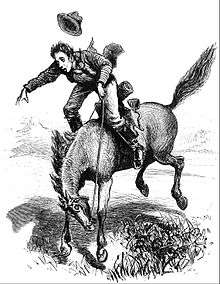Cayuse horse

Cayuse is an archaic term used in the American West, usually referring to a feral or by some who didn't know better of a low-quality horse or pony. Others admired the Cayuse for its endurance.
In British Columbia, the variant word cayoosh refers to a particular breed of mountain pony with shorter legs and large hindquarters, typically also of Indian husbandry.
The Cayuse was a sturdy pony with great endurance bred by the Native American people of the Cayuse Tribe in North Eastern Oregon.
The origin of the word is a Native American adaptation of the Spanish caballo, with the -s ending a noun form in Salishan languages. A variant adaptation, kiuatan, with a Sahaptian -tan ending, is the main word for "horse" or "pony" in the Chinook Jargon, although cayuse or cayoosh was also used in some areas. For this reason, some horses owned by Native American people were dubbed "cayuse,".
Two cayuses that made history were Nimpo and Stuyve who were depicted in Richmond P. Hobson, Jr.'s book Grass Beyond The Mountains. Both horses had been captured by a local Native American named Thomas Squinas near Nimpo Lake in the Chilcotin District of British Columbia. Hobson described the two cayuses as the best horses that he owned, because of their unrelenting spirit and hardiness that helped them survive the extreme conditions in northern British Columbia. There is also an example of it in John Steinbeck's book, The Red Pony.
The horse is mentioned in "Don't Fence Me In", a popular American song written in 1934 by Cole Porter and Robert Fletcher. There is a line "On my Cayuse, let me wander over yonder...' It was recorded by Roy Rogers, Gene Autry and Bing Crosby, among many others.